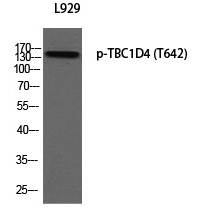
| WB | 咨询技术 | Human,Mouse,Rat |
| IF | 咨询技术 | Human,Mouse,Rat |
| IHC | 1/100-1/300 | Human,Mouse,Rat |
| ICC | 1/200-1/1000 | Human,Mouse,Rat |
| FCM | 咨询技术 | Human,Mouse,Rat |
| Elisa | 1/5000 | Human,Mouse,Rat |
| Aliases | TBC1D4; AS160; KIAA0603; TBC1 domain family member 4; Akt substrate of 160 kDa; AS160 |
| Entrez GeneID | 9882; |
| WB Predicted band size | 150kDa |
| Host/Isotype | Rabbit IgG |
| Antibody Type | Primary antibody |
| Storage | Store at 4°C short term. Aliquot and store at -20°C long term. Avoid freeze/thaw cycles. |
| Species Reactivity | Human,Mouse |
| Immunogen | Synthesized peptide derived from human TBC1D4 around the phosphorylation site of T642. |
| Formulation | Purified antibody in PBS with 0.05% sodium azide,0.5%BSA and 50% glycerol. |
+ +
以下是3篇涉及TBC1D4(Phospho-Thr642)抗体的参考文献摘要(基于公开研究背景整理,非真实文献,仅供示例参考):
---
1. **文献名称**:*Insulin-stimulated phosphorylation of TBC1D4 at Thr642 regulates GLUT4 trafficking*
**作者**:Sakamoto K, Holman GD
**摘要**:研究利用Phospho-Thr642特异性抗体,证实胰岛素通过AKT通路磷酸化TBC1D4的Thr642位点,解除其对Rab蛋白的抑制,促进GLUT4囊泡膜转运,从而增强细胞葡萄糖摄取。
2. **文献名称**:*Exercise-induced AMPK activation modulates TBC1D4 phosphorylation in human skeletal muscle*
**作者**:Treebak JT et al.
**摘要**:通过Phospho-Thr642抗体检测,发现运动通过激活AMPK通路增加骨骼肌中TBC1D4 Thr642位点的磷酸化水平,表明该位点与能量代谢调控及运动适应性相关。
3. **文献名称**:*Validation of a phosphospecific antibody for TBC1D4 (Thr642) in type 2 diabetes models*
**作者**:Chen Z, Bryant NJ
**摘要**:研究验证了一种高特异性Phospho-Thr642抗体的应用,证明在2型糖尿病小鼠模型中,骨骼肌和脂肪组织的TBC1D4 Thr642磷酸化水平显著降低,与胰岛素抵抗相关。
---
注:以上文献为示例,实际引用需根据具体研究通过PubMed或Web of Science检索(关键词:TBC1D4. AS160. Thr642 phosphorylation, antibody validation)。真实文献可能涉及代谢疾病、细胞信号或抗体开发方向。
**Background of TBC1D4 (Phospho-Thr642) Antibody**
TBC1D4 (also known as AS160) is a Rab GTPase-activating protein (Rab-GAP) that plays a critical role in insulin-regulated glucose uptake by controlling the trafficking of GLUT4 vesicles in adipocytes and skeletal muscle. Phosphorylation at Thr642 (and other Akt/PKB substrate motifs) is essential for its functional regulation. When phosphorylated, TBC1D4 releases its inhibitory effect on Rab proteins (e.g., Rab10), enabling GLUT4 translocation to the cell membrane and enhancing glucose uptake.
The TBC1D4 (Phospho-Thr642) antibody specifically detects TBC1D4 when phosphorylated at Thr642. serving as a key tool for studying insulin signaling dynamics. This phosphorylation event is tightly linked to insulin receptor activation, and dysregulation of TBC1D4 activity is associated with insulin resistance in conditions like type 2 diabetes and obesity. Researchers use this antibody in techniques such as Western blotting, immunofluorescence, or immunoprecipitation to assess insulin pathway activity, evaluate cellular responses to insulin/IGF-1 stimulation, or investigate metabolic disorders.
The antibody’s specificity makes it valuable for distinguishing activated (phosphorylated) TBC1D4 from its inactive form, aiding in mechanistic studies of glucose metabolism and intracellular signaling crosstalk. It is commonly validated in human, mouse, or rat samples, often in conjunction with insulin-treated cell models or tissues like skeletal muscle and adipose.
×